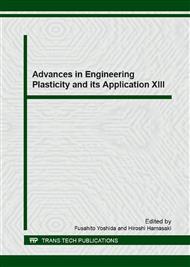[1]
Jeswiet, J., et al., Asymmetric Single Point Incremental Forming of Sheet Metal. CIRP Annals - Manufacturing Technology, 54 (2005) 88-114.
DOI: 10.1016/s0007-8506(07)60021-3
Google Scholar
[2]
Malhotra, R., Xue, L., Belytschko, T., & Cao, J. Mechanics of fracture in single point incremental forming. Journal of Materials Processing Technology, 212(2012) 1573-1590.
DOI: 10.1016/j.jmatprotec.2012.02.021
Google Scholar
[3]
Silva MB, Skjoedt M, Bay N, Martins PAF. Revisiting single point incremental forming and formability/failure diagrams by means of finite elements and experimentation. Journal of Strain Analysis for Engineering Design. 44 (2009) 221-234.
DOI: 10.1243/03093247jsa522
Google Scholar
[4]
Fiorentino A, Attanasio A, Marzi R, Ceretti E, Giardini C. On forces, formability and geometrical error in metal incremental sheet forming. International Journal of Materials and Product Technology. 40 (2011) 277-295.
DOI: 10.1504/ijmpt.2011.039936
Google Scholar
[5]
Liu Z, Daniel W, Li Y, Liu S, Meehan P. Multi-pass deformation design for incremental sheet forming: Analytical modelling, finite element analysis and experimental validation. Journal of Materials Processing Technology. 214 (2014) 620-634.
DOI: 10.1016/j.jmatprotec.2013.11.010
Google Scholar
[6]
Li Y, Daniel W, Liu Z, Lu H, Meehan P. Deformation mechanics and efficient force prediction in single point incremental forming. Journal of Materials Processing Technology. 221 (2015) 100-111.
DOI: 10.1016/j.jmatprotec.2015.02.009
Google Scholar
[7]
Al-Ghamdi, K. A., & Hussain, G. Threshold tool-radius condition maximizing the formability in SPIF considering a variety of materials: Experimental and FE investigations. International Journal of Machine Tools and Manufacture, 88(2015) 82-94.
DOI: 10.1016/j.ijmachtools.2014.09.005
Google Scholar
[8]
Madeira T, Silva CMA, Silva MB, Martins PAF. Failure in single point incremental forming. The International Journal of Advanced Manufacturing Technology. 80 (2015) 1471-1479.
DOI: 10.1007/s00170-014-6381-7
Google Scholar
[9]
Emmens, W. C., & Van den Boogaard, A. H. An overview of stabilizing deformation mechanisms in incremental sheet forming. Journal of Materials Processing Technology, 209(2009) 3688-3695.
DOI: 10.1016/j.jmatprotec.2008.10.003
Google Scholar
[10]
Jackson, K., & Allwood, J. The mechanics of incremental sheet forming. Journal of materials processing technology, 209(2009) 1158-1174.
DOI: 10.1016/j.jmatprotec.2008.03.025
Google Scholar
[11]
Eyckens, P., Belkassem, B., Henrard, C., Gu, J., Sol, H., Habraken, A. M., .. & Van Houtte, P. Strain evolution in the single point incremental forming process: digital image correlation measurement and finite element prediction. International journal of material forming, 4(2011).
DOI: 10.1007/s12289-010-0995-6
Google Scholar


